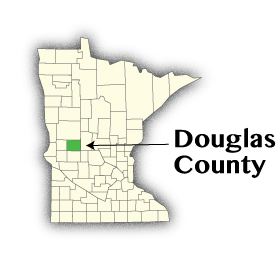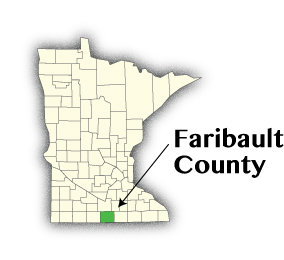By Tim O'Neill
September 2017

Established in 1858, the same year Minnesota was admitted to the Union as the 32nd state, Douglas County is currently home to an estimated 37,456 people. Well over one-third of the county's population, over 13,500 people, live in the county seat, Alexandria. Alexandria was also settled in 1858, apparently a wonderful year for establishing cities, counties, and states.
Growth was swift for Douglas County at first. Between 1870 and 1900, the county ballooned by 13,725 people or an average annual growth rate of 8.0 percent. Then things stalled. Between 1900 and 1970, the county added just 4,928 people, barely scratching 0.4 percent average annual growth. Luckily, the county has witnessed a resurgence, with over 14,500 people moving within its borders since 1970. In fact, the county has grown more rapidly than the state as a whole since 1970. Maybe this newfound growth has to do with the rediscovery of the county's 250-plus lakes. "The lakes of Douglas County are unsurpassed for the purity of their waters, the beauty of their scenery and general attractiveness. There is a large number of them…but it is not the number so much as it is their beauty and variety which impresses anyone who studies them in detail."1
With 1,323 establishments supplying 18,384 covered jobs, Douglas County comes in as Minnesota's 23rd largest-employing county. The county's total employment dipped by 4.4 percent during the great recession, before climbing like clock-work between 2010 and 2016. Overall, Douglas County is nearly 700 jobs above its pre-recessionary peak, which it hit in 2008. Douglas County beats out 55 other Minnesota counties when it comes to employment growth since 2008. In fact, 38 of those 55 counties are still below their 2008 levels of employment. Douglas County is in good company for growth in Minnesota.
Those industries that promoted Douglas County's recent growth include Manufacturing (up by 677 jobs since 2010), Health Care and Social Assistance (up by 331 jobs), Other Services (up by 221 jobs), Construction (up by159 jobs), and Accommodation and Food Services (up by 108 jobs). At the other end of the spectrum, those industries experiencing weakness since 2010 include Information (down 145 jobs), Transportation and Warehousing (down 58 jobs), and Wholesale Trade (down 31 jobs).
| 2016 Estimates | Douglas County | Minnesota |
|---|---|---|
| Population | 37,456 | 5,519,952 |
| Labor Force | 20,931 | 3,093,153 |
| Average Unemployment | 2.7% (562 people) | 3.4% (106,122 people) |
| Median Annual Earnings | $29,898 | $33,527 |
| Cost of Living, Individual | $24,904 ($11.97 per hour) | $29,856 ($14.35 per hour) |
| Cost of Living, Average Family | $43,676 ($14.00 per hour) | $55,200 ($17.69 per hour) |
| Source: DEED Local Area Unemployment Statistics July 2017; DEED Cost of Living in Minnesota 2017; U.S. Census Bureau, 2016 American Community Survey Estimates | ||
| Top Industries of Employment | 2016 Annual Data | 2010 – 2016 Percent Change | |||
|---|---|---|---|---|---|
| Number of Firms | Number of Jobs | Average Wage | Employment | Average Wage | |
| Total, All Industries | 1,323 | 18,384 | 40,456 | 8.5% | 21.6% |
| Education and Health Services | 161 | 4,351 | 42,848 | 7.8% | 22.6% |
| Trade, Transportation, and Utilities | 314 | 4,086 | 35,360 | -1.9% | 19.3% |
| Manufacturing | 82 | 3,279 | 55,848 | 26.0% | 22.2% |
| Leisure and Hospitality | 148 | 2,267 | 14,768 | 6.9% | 25.7% |
| Source: DEED Quarterly Census of Employment and Wages (QCEW) | |||||
1Larson, Constant, editor. History of Douglas and Grant Counties: Their Peoples, Industries and Institutions. Indianapolis, B.F. Bowen & Company, 1916, p. 59.

Founded in 1855, Faribault County is the state's 60th most populous county. With just under 14,000 residents, Faribault's total population has gradually declined since the 1940s. These declines are not unique to Faribault County, however, as every Minnesota county bordering Iowa has seen little to no population growth in recent decades. The county seat, Blue Earth, is home to roughly one-quarter of the county's total population. Other Faribault County cities breaking 1,000 people include Wells (2,225 people) and Winnebago (1,367 people). All told, just over two-thirds of the county's population lives in its 11 cities, with the rest scattered across 20 townships. It should be noted that the City of Faribault is located in Rice County. Check with Employment Review in August, 2018, to hear more about Rice County.
Faribault County is the birthplace of the ice cream sandwich, is home to Minnesota's first stained-glass window, has the world's largest statue of the Jolly Green Giant, and includes a former hometown of Walter Mondale.1
Along with its population, Faribault County's total employment has also been in decline. Between 2006 and 2016 the county's total employment dropped by 13.9 percent or 754 jobs. Between 2015 and 2016 total employment dropped by 3.1 percent or 148 jobs. Comparatively, Minnesota's total employment increased by 5.1 percent between 2006 and 2016 and by 1.4 percent between 2015 and 2016. Recent employment losses are largely caused by weaknesses in Health Care and Social Assistance, Educational Services, and Manufacturing. There have been recent gains in Public Administration, Retail Trade, and Wholesale Trade.
Agriculture is where Faribault County really shines. As of the United States Department of Agriculture's 2012 Census of Agriculture, Faribault County had 824 farms accounting for 390,139 acres. The total market value of products sold was $414.2 million, which was a 43 percent increase from 2007. Digging into the numbers, Faribault County ranks especially high for grains, oilseeds, dry beans, and dry peas (fifth among the state's 87 counties), corn for grain (seventh among the state's 87 counties), and hogs and pigs (10th among the state's 87 counties).2
| 2016 Estimates | Faribault County | Minnesota |
|---|---|---|
| Population | 13,935 | 5,519,952 |
| Labor Force | 7,149 | 3,093,153 |
| Average Unemployment | 3.8% (273 people) | 3.4% (106,122 people) |
| Median Annual Earnings | $27,692 | $33,527 |
| Cost of Living, Individual | $25,021 ($12.03 per hour) | $29,856 ($14.35 per hour) |
| Cost of Living, Average Family | $43,707 ($14.01 per hour) | $55,200 ($17.69 per hour) |
| Source: DEED Local Area Unemployment Statistics July 2017; DEED Cost of Living in Minnesota 2017; U.S. Census Bureau, 2016 American Community Survey Estimates | ||
| Top Industries of Employment | 2016 Annual Data | 2010 – 2016 Percent Change | |||
|---|---|---|---|---|---|
| Number of Firms | Number of Jobs | Average Wage | Employment | Average Wage | |
| Total, All Industries | 433 | 4,690 | $37,232 | -6.4% | 26.3% |
| Education and Health Services | 50 | 1,096 | $34,164 | -13.2% | 10.6% |
| Manufacturing | 23 | 1,092 | $49,244 | -2.2% | 31.2% |
| Trade, Transportation, and Utilities | 115 | 807 | $29,744 | -0.5% | 14.2% |
| Public Administration | 21 | 376 | $27,924 | 5.3% | 12.8% |
| Source: DEED Quarterly Census of Employment and Wages (QCEW) | |||||
1Blue Earth Minnesota. Accessed Sept. 12, 2017.
2"2012 Census of Agriculture." Faribault County Profile, United States Department of Agriculture. Accessed Sept. 12, 2017.

Fillmore County is located in the far southeastern part of Minnesota, along the border with neighboring Iowa and within the Rochester Metropolitan Statistical Area. Main transportation arteries in the county include U.S. Highways 52 and 63, which both cut the county from north to south. Located along Highway 52 and nearly in the center of Fillmore County, is the county seat of Preston. Preston, with an estimated population of 1,305 people, accounts for less than one-tenth of the county's total population. Overall, just over 63 percent of the county's total population live within its 14 cities, the largest cities being Chatfield (2,804 people), Spring Valley (2,425 people), Rushford (1,717 people), Preston, and Harmony (998 people).
Established in 1853, Fillmore County originally included all or parts of Dodge, Houston, Mower, Olmsted, Wabasha and Winona counties. As such, Fillmore County was Minnesota's most populous county through 1870.1 Its population peaked in 1895 at 28,599 people, declined by 26.6 percent through the next century, and has since stabilized around 21,000 people. Much of Fillmore County's growth and decline can be linked to railroads which left in the late 1970s. Early development was also attributable to abundant water resources, sawmills, gristmills, feed mills, and woolen mills.2
Agriculture played a large part in Fillmore County's past economy and still does today. Over time, smaller farms have been combined into much larger ones, especially with increasingly advanced farming technology and equipment. As of the 2012 Census of Agriculture, there were 1,553 farms in the county with the market value of products sold topping $342.2 million. Notably, Fillmore County ranks number one in the state for value of sales of sheep, goats, wool, mohair, and milk, and number two in the state for value of sales of horses, ponies, mules, burros, and donkeys.3 Top crops include oats for grain, corn for silage, and forage-land used for hay.
Similar to Houston County to the east, as well as Howard, Winneshiek, and Allamakee counties to the south in Iowa, Fillmore County has an older population. The median age in 2015 was 43.0 years, higher than Minnesota's median age of 37.9 years.
| 2016 Estimates | Fillmore County | Minnesota |
|---|---|---|
| Population | 21,003 | 5,519,952 |
| Labor Force | 11,556 | 3,093,153 |
| Average Unemployment | 3.1% (360 people) | 3.4% (106,122 people) |
| Median Annual Earnings | $30,444 | $33,527 |
| Cost of Living, Individual | $27,293 ($13.12 per hour) | $29,856 ($14.35 per hour) |
| Cost of Living, Average Family | $47,122 ($15.10 per hour) | $55,200 ($17.69 per hour) |
| Source: DEED Local Area Unemployment Statistics July 2017; DEED Cost of Living in Minnesota 2017; U.S. Census Bureau, 2016 American Community Survey Estimates | ||
| Top Industries of Employment | 2016 Annual Data | 2010 – 2016 Percent Change | |||
|---|---|---|---|---|---|
| Number of Firms | Number of Jobs | Average Wage | Employment | Average Wage | |
| Total, All Industries | 632 | 6,134 | $32,552 | 2.6% | 17.4% |
| Education and Health Services | 45 | 1,558 | $28,444 | 6.3% | 17.4% |
| Trade, Transportation, and Utilities | 146 | 1,517 | $36,764 | 21.7% | 14.4% |
| Manufacturing | 43 | 694 | $43,056 | -3.2% | 14.8% |
| Leisure and Hospitality | 82 | 650 | $12,792 | 14.0% | 43.9% |
| Source: DEED Quarterly Census of Employment and Wages (QCEW) | |||||
1"About Fillmore County." Fillmore County. Accessed Sept. 12, 2017.
2Ibid.
3"2012 Census of Agriculture." Fillmore County Profile, United States Department of Agriculture. Accessed Sept. 12, 2017.

The last of this month's county spotlights tours Minnesota's southern border with Iowa once again. Founded in 1855, Freeborn County was originally settled by Norwegian, German, Danish, Irish, and Czech peoples who were attracted to the region's rich farmland and numerous lakes. Today Freeborn County's diversity has expanded to include those of Hispanic and Latino origins, which is helping to bolster the county's declining population. More specifically, where the county's total population contracted by 5.2 percent between 2000 and 2015, the Hispanic and Latino population spiked by 40.1 percent.
Fast Fact: In 1835 Lieutenant Albert Miller Lea explored and surveyed what is now Freeborn County with the First United States Dragoons. Lea's name was eventually given to one of the region's lakes as well as the city which was founded around it in 1855.1 Today, with a population of 17,667 people, Albert Lea is Freeborn County's largest city and is also the county seat.
Nearly 37 percent of Freeborn County's total employment is in Manufacturing and Retail Trade, with Manufacturing accounting for over 2,500 jobs and Retail Trade another 1,900 jobs. Roughly two-thirds of the county's manufacturing employment is in Food Manufacturing (1,243 jobs) and Fabricated Metal Product Manufacturing (400 jobs). The majority of Retail Trade employment is in General Merchandise Stores (412 jobs), Food and Beverage Stores (372 jobs), Motor Vehicle and Parts Dealers (319 jobs), and Gasoline Stations (299 jobs).
Education and Health Services accounts for over 2,800 jobs in Freeborn County, with 94.6 percent of such jobs in the city of Albert Lea alone. Such employment may take a substantial hit, however, as the Mayo Clinic has opted to consolidate some services at its Albert Lea Campus to Austin, Minnesota.2
Mention should also be made of Freeborn County's 1,122 farms. The market value of products sold at these farms equaled $416.0 million in 2012, up 63 percent from 2007. Zooming in, Freeborn County ranks 37th in the nation (of 2,889 counties) for inventory in hogs and pigs.
| 2016 Estimates | Freeborn County | Minnesota |
|---|---|---|
| Population | 30,446 | 5,519,952 |
| Labor Force | 15,795 | 3,093,153 |
| Average Unemployment | 3.5% (551 people) | 3.4% (106,122 people) |
| Median Annual Earnings | $27,777 | $33,527 |
| Cost of Living, Individual | $24,753 ($11.90 per hour) | $29,856 ($14.35 per hour) |
| Cost of Living, Average Family | $43,378 ($13.90 per hour) | $55,200 ($17.69 per hour) |
| Source: DEED Local Area Unemployment Statistics July 2017; DEED Cost of Living in Minnesota 2017; U.S. Census Bureau, 2016 American Community Survey Estimates | ||
| Top Industries of Employment | 2016 Annual Data | 2010 – 2016 Percent Change | |||
|---|---|---|---|---|---|
| Number of Firms | Number of Jobs | Average Wage | Employment | Average Wage | |
| Total, All Industries | 774 | 12,061 | $39,572 | -0.6% | 21.8% |
| Trade, Transportation, and Utilities | 227 | 2,867 | $34,632 | 8.9% | 20.0% |
| Education and Health Services | 61 | 2,813 | $46,228 | -9.7% | 22.6% |
| Manufacturing | 54 | 2,504 | $45,864 | 3.5% | 14.4% |
| Leisure and Hospitality | 79 | 1,026 | $14,144 | -3.9% | 27.7% |
| Source: DEED Quarterly Census of Employment and Wages (QCEW) | |||||
1"The Information Bureau: Albert Miller Lea.", Minnesota Historical Society. Accessed Sept. 12, 2017.
2Richert, Catharine. "AG Swanson won't sue Mayo over Albert Lea hospital shutdowns." MPR News, Sept. 11, 2017. Accessed Sept. 13, 2017.